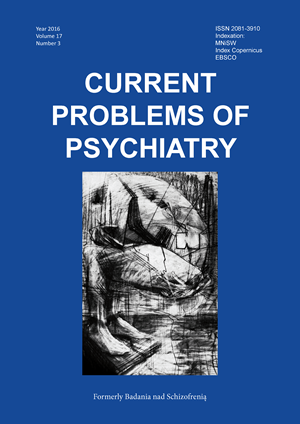Comparative characteristics of professional predispositions of medical personnel
DOI:
https://doi.org/10.1515/cpp-2016-0019Keywords:
job predispositions, nursing staffAbstract
Professional predispositions are an important component characterising people working as health care professionals. The aim of this study was to compare professional predispositions of students at medical courses with professionally active nurses. The study methods included a survey (SOPZ) and the Delta questionnaire. The analysis showed there were no differences in levels of sense of threat, responsibility and creativity in all analysed group, as well as while there was a differentiating influence of the sense of control in the analysed group of students.
References
1. Parkes KR. Coping in stressful episodes: the role of individual differences, environmental factors, and situational characteristics. J Pers Soc Psychol., 1986;51(6):1277-92.
2. Barlem JG, Lunardi VL, Barlem EL, Ramos AM, Figueira AB, Fornari NC. Nursing beliefs and actions in exercising patient advo-cacy in a hospital context. Rev Esc Enferm USP., 2015;49(5):811-8.
3. Burgess L, Irvine F, Wallymahmed A. Personality, stress and coping in intensive care nurses: a descriptive exploratory study. Nurs Crit Care., 2010;15(3):129-40.
4. Baldacchino DR, Galea P. Student nurses' personality traits and the nursing profession: part 2. Br J Nurs., 2012;21(9):530-5.
5. Watson R, Deary I, Thompson D, Li G. A study of stress and burn-out in nursing students in Hong Kong: a questionnaire survey. Int J Nurs Stud. 2008; 45(10):1534-42.
6. Jenkins SH, Astroth KS, Woith WM. Non-Critical-Care Nurses' Perceptions of Facilitators and Barriers to Rapid Response Team Activation. J Nurses Prof Dev., 2015;31(5):264-70.
7. Shimizutani M1, Odagiri Y, Ohya Y, Shimomitsu T, Kristensen TS, Maruta T, Iimori M. Relationship of nurse burnout with personality characteristics and coping behaviors. Ind Health, 2008;46(4):326-35.H.
8. Ellershaw J1, Fullarton C, Rodwell J, Mcwilliams J. Conscientiousness, openness to experience and extraversion as predictors of nursing work performance: a facet-level analysis. J Nurs Manag., 2015; 3.
9. Hudek-Knezevic J., Kalebic MaglicaB., Krapić N. Personality, organizational stress, and attitudes toward work as prospective predictors of Professional burnout in hospital nurses. Croat Med J.,2011:15:52(4):538-49.
10. Canadas-De la Fuente, Vargas C., San Luis C., Garcia I. Risk factors and prevalence of burnout syndrome In the nursing profession. Int J Nurs Stud., 2015;52(1):240-9.
11. Bohle P., tilley A.J. Predicting mood change on Wight Shift. Ergonomics,1993:36(1-3):125-33.
12. Tornroos M., Hintsanen M., Hintsa T., Jokela M., Pulkki-Raback L., Hutri-Kahonen N., Keltikangas-Jarvinen L. Associations between five-factor model traits and perceived job strain: a population-based study. J Occup Health Psychol.,2013;18(4):492-500.
13. Strelau J., Zawadzki B. Kwestionariusz temperament PTS., Warszawa;1998:s.67-75.
14. Drwal R.Ł. Opracowanie kwestionariusza Delta do pomiaru poczucia kontroli. Studia Psychologiczne, 1979;1:67-83.
15. Parker JDA, Endler NS. Coping with doping assessment: A critical review. European Journal of Personality, 1992; 6(5).
16. Dudek B., Koniarek J., Szymczak W. Stres związany z pracą a teoria zachowania zasobów Stevana Hobfolla. Medycyna Pracy, 2007;58(4):317-325.
17. Litzke S., Schuh H. Stres, lobbing i wypalenie zawodowe, Gdańskie Wydawnictwo Psychologiczne, Gdańsk 2006.
Downloads
Published
Issue
Section
License
Copyright (c) 2016 Authors

This work is licensed under a Creative Commons Attribution-NonCommercial-NoDerivatives 3.0 Unported License.


